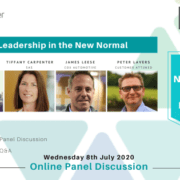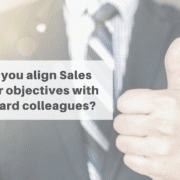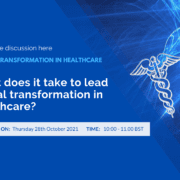B2B Leaders – Make Trust Building A Reality – B2B Trust Series Part 2
B2B Leaders, Make Trust Building A Reality
In this blog Dr Mark Hollyoake, addresses Trust at organisation /leadership level and your role as a leader in its development with your customers or suppliers.
Trust in a B2B context starts at organisation/leadership level and tends to be strategic in nature, so we start here first. At leadership level you are responsible for the strategic nature of trust building both internally and externally. What does this mean for you as a leader?
As a leader you not only set out the company’s / organisation’s relationship; behaviours, attitudes, ethics and values; you also live them and oversee that your people deliver them. Your own people, and the people for your key/core customer relationships, will be watching to see if your intention matches your actions, level of passion, attitude, commitment, clarity and articulation of your message.
- How does this manifest itself in the relationship? The key drivers of trust at organisational / leadership level are:

Let’s look at each in turn:
-
Commitment to the relationship intent.
Commitment is an area often confused with being at the centre of trust building – it is in effect an enabler and indicator. Both sides of the relationship at the operations and interpersonal levels will be looking to the leadership / organisational level for direction and an indication of the strength and importance they attach to the delivery of the relational intent.
Any slight divergence in commitment from just one member of the leadership team could get seized upon by those sceptics within the relationship as an indicator of differing commitment and mis trust starts to creep in. It is also worth bearing in mind that the relationship intent is unlikely to be delivered in 5 minutes and may require many months or even years.
This needs to be matched by the consistent focus of the leadership teams on the development of the relationship and the delivery of the intent, even if it has its ups and downs. The lower levels of the organisation and relational dyad are continually making themselves vulnerable to each other on the understanding that their combined ability, the way they work together and each other’s credibility will deliver the mutual value expected.
They look to the leadership team for reassurance that the risk is paying off and trust isn’t being misplaced.
-
The strength of the relational intent; is the mutual benefit worth the actualisation.
A key part of the leadership team’s role in the development of relational trust is determining the actual mutual value on offer, through the actualisation of the relational intent. In essence, why bother!
Remember, mutual benefit doesn’t directly equate to a financial gain and may extend to many other benefit areas: knowledge, expertise, skills, risk mitigation, advocacy and active referrals, etc. Leaders need to demonstrate the values, ethics and trust building culture of the organisation they represent.
These are often referred to as the ‘corporate moral bonds’. Leaders at a strategic level are the epitomisation of the corporate moral bonds and responsible for upholding them in all of their interactions. They act as the face of the organisation at this strategic trust building stage:
- Development of relational loyalty: A reduction in the potential for coercive/opportunistic behaviour and a focus on the opportunities the relationship can deliver.
- Reciprocity (Szompka, 2016). Relationship investment for medium to long term return and a demonstration of the relational opportunity.
- The common good: The relationships intent, the clarity of the vision, direction and working to a shared agenda.
- Credibility: the respected person, organisation, brand, etc has actual, real and not fake achievements.
- Mutual benefit: What you get out is proportional to the effort put in, however, also to the result, in essence the mutuality of the relationship.
The benefit needs to be mutual and fair; the leadership teams need to agree what mutual looks like for them related to the relational intent. It isn’t necessarily 50:50, just as long as both sides see it as fair and mutual.
If both leadership teams view the actualisation as being worth it for the delivery of the mutual value, then this strengthens the relational intent and buy-in from the lower levels of the relational dyad. They can see why we are doing this and the upsides in making it a reality.
This makes the vulnerability and risk worthwhile. This builds trust between both sides as their willingness to take the step, make themselves vulnerable and work together has paid off, so why wouldn’t you do it again and again!
-
Clarity and transparency of the communications between both sides at this level.
I often come across communications that kick off with a PR fanfare only to get overtaken by the next management initiative. It is important to have a clear communications strategy that converts into a plan covering both sides of the relationship at all levels, delivering a consistent message over time.
The messaging and style of the communication need to be clear, concise and consistent. People need to know that this is important, what they need to do and how they need to do it. The communication needs to be transparent, telling ‘the good’ and the ‘not so good’ in equal measure.
Any discontinuity in the style, frequency, format and transparency has the potential to let mis-trust creep in. An effective way to facilitate really open and free flowing communication is to instigate a communication loop that enables communications to flow across, up and down the relationship. With all levels participating, not just the traditional top down.
-
The internal discipline to make it happen at the lower levels of both sides of the organisation involved on the relationship.
An area often overlooked or not fully considered when the organisation/leadership levels are exploring the purpose, intent and expectations from the relationship: as a leadership team are we effective enough at getting our people to actually ‘make it happen’.
The intent may be sound, realistic and eminently doable however, the process, system and people at the operations and interpersonal level disregard the intent, partly take notice of it or do what they think is best based on their interpretation.
A simple example drawn from fast moving consumer goods would be the agreement at organisational level to undertake a retail orientated joint campaign across all store formats. This would include: front of store display/feature, fixture feature, gondola end feature, in conjunction with a billboard and social media campaign.
The campaign is launched, yet only 60% of the stores comply with the front of store display/feature and 10% stores don’t even bother to do the fixture feature. Despite leadership attention, full compliance was never achieved and the joint activity failed to deliver the mutual value intended and expected.
Trust has been eroded and the supplier looks elsewhere for a retailer that has the internal discipline to make it happen. So, when developing the relational intent, expectation and engagement as a leadership team with your opposite numbers, make sure you can get your organisation to deliver what you intend.
Summary
These are the core elements of relational trust building between both sides of a relational dyad at the leadership level. Any slip or divergence across the four areas outlined, opens up the relationship to the opportunity for dissonance and mistrust to creep in. If applied consistently by both leadership teams across the relational dyad they form the key elements of strategic relational trust building.
With the key drivers identified the next paper looks at how the key drivers are implemented and activated to achieve the relational intent and the delivery of the mutual value expected.
B2B Trust is what sets companies apart, read more about Dr Mark’s B2B Trust DNA Model here.
Want to know more about Building B2B Trust in your company? Talk to Dr Mark
- Leap of Faith by Dr Mark Hollyoake featured in the Journal of Sales Transformation - May 13, 2024
- Stop hiding behind your computer and get out to see your customers! - March 6, 2024
- B2B Trust Research: What are Boundary Spanners? - January 31, 2024








